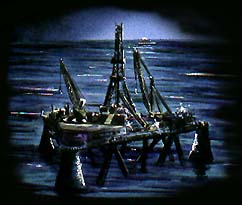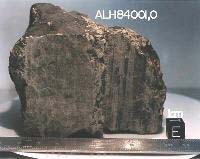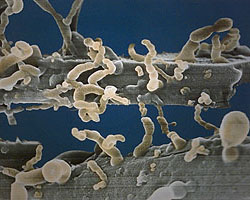| NANOBES:
Introduction
|
||
Discovery...

Philippa Uwins, a geologist studying sandstone core examples from an oil exploration project off the West Australian coast, made a dramatic discovery back in 1996 but it is only now (1999) that her findings are exciting the scientific community. What is all the fuss about? Well maybe, just maybe, Philippa might have revealed a vital clue towards understanding the links and processes dividing living and non-living structures and further evidence to support the existence of life on other planets. What did she discover: NANOBES! Here
at Micscape Magazine, we thought we would explore her discovery and publish
an introduction for you into the debate, as well as providing you with
links to additional sources of information.
|
||
 |
||
| Nanobe Colony 35,000x | ||
| How it
began...
Philippa Uwins and her colleagues at the University of Queensland, Australia, noticed strange structures growing on sandstone rock samples they had broken open for studying. The rock samples had been retrieved from 3 to 5 Kilometres below the ocean bed where atmospheric pressure is around 2000x normal, and temperatures range between 115 to 170 degs Centigrade; not an easy place for living things to flourish! They're spreading...
They're
alive...
What
are they..?
Like
bacteria but not bacteria...
The nanobes from the sandstone are not identical to the structures within ALH84001 but they are roughly the same size. Their discovery lends additional weight to the claims about nanofossils because, up to now, the argument against nanofossils being within the martian rock relied strongly on there being no living examples of nano-sized cells. One
of the lead researchers behind the Martian meteorite claims, David McKay
of NASA’s Johnson Space Centre, is said to be fascinated by the newly announced
discovery and is reported to have said: "It's something that shows that
we just don't understand the small end of the spectrum. There are implications
on that end of the size spectrum for the origin of life."
Nanobes
everywhere...
He
believes such bacteria form the bulk of living things on Earth and may
be responsible for the rusting of metal and the "greening" of copper but
the tiny organisms have eluded conventional tools and avenues of research.
Opening
a can of worms...
Dr.Uwins' team has resisted calling her discovery 'nanobacteria' and instead has given them the novel name of 'nanobes' until more is discovered and researched regarding their evolutionary path and real nature. She accepts that the evidence gained to-date is still open to a variety of interpretations especially as the study of subterranean organisms is still in its infancy with many fresh surprises to come. Some experts, including Paul Davies one of the worlds leading astrophysicists and philosophers, believe there must be transitional stages to life, where the dividing lines between what is alive and what is not, blur and merge. The smaller an organism is, the more able it would be to form by chance. If life can exist at this level deep within the extremes of the earth, then there is a powerful suggestion that they can live within the rock of other planets - fuelling the belief by many that life is not a one-off chemical freak of our planet but a natural progression of the emergence of life throughout the universe. If
the work done by Dr. Philippa Uwins and her colleagues proves valid in
the face of additional investigation and analysis, the discovery of nanobes
may become one of the most remarkable and significant discoveries of our
age!
Dr.
Uwins, along with Queensland colleagues Richard Webb and Anthony Taylor,
published their findings in the November/December 1998 issue of American
Mineralogist.
Based
on a variety of sources as follow:-
|
||
| Introduction | Scientific Paper | Images & Links |
| About Philippa & The Team | The Discovery Team's Web Site | Credits & Permissions |
| Back | Exit | Next | ||
| All
material is copyright of either Micscape Magazine or contributing parties.
Please visit the Discovery Team's web site
if you wish to use any of their images or material for both commercial and non-commercial publication. |
||
 Current
scientific knowledge suggest that the smallest living organisms are bacteria,
but these new structures - dubbed 'nanobes' - are in fact much smaller
at 1/10 of a bacterium's size: a nanobacteria, possibly? The scientific
community is divided on their thoughts on this with many experts suggesting
that nanobacteria are simply too small to contain the all-important genetic
material and cell processes associated with small life-forms. The
existence of nanobacteria has been suggested for over 10 years. They were
one of the lines of evidence used by Nasa scientists to claim that tiny
structures in a Martian rock (ALH84001) were fossil bacteria.
Current
scientific knowledge suggest that the smallest living organisms are bacteria,
but these new structures - dubbed 'nanobes' - are in fact much smaller
at 1/10 of a bacterium's size: a nanobacteria, possibly? The scientific
community is divided on their thoughts on this with many experts suggesting
that nanobacteria are simply too small to contain the all-important genetic
material and cell processes associated with small life-forms. The
existence of nanobacteria has been suggested for over 10 years. They were
one of the lines of evidence used by Nasa scientists to claim that tiny
structures in a Martian rock (ALH84001) were fossil bacteria.
 Many
scientists argue that these tiny structures were formed by geological processes,
not biological ones, stating that there is no evidence for life forms smaller
than known microbes on Earth. However, there are other scientists and researchers
who strongly claim that numerous examples of nanobacteria exist. One of
the leading advocates is Dr Robert Folk of the University of Texas. His
work involved studying mineral deposits near volcanoes and many years before
the public's exposure to the mars rock announcement, he had claimed to
have identified bacteria very much smaller than previously discovered.
Many
scientists argue that these tiny structures were formed by geological processes,
not biological ones, stating that there is no evidence for life forms smaller
than known microbes on Earth. However, there are other scientists and researchers
who strongly claim that numerous examples of nanobacteria exist. One of
the leading advocates is Dr Robert Folk of the University of Texas. His
work involved studying mineral deposits near volcanoes and many years before
the public's exposure to the mars rock announcement, he had claimed to
have identified bacteria very much smaller than previously discovered.